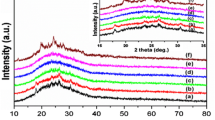Abstract
In the current study, we have described the synthesis and the physical properties of poly(aniline-co-m-bromoaniline) conducting copolymers. The copolymers of different composition are essentially obtained by varying the molar feed ratio of the two monomers. The higher solubility of the copolymers could be procured as compared to polyaniline (PA) in different solvents. The electrical conductivity has been studied by two-probe method; at room temperature, the conductivity of the copolymer decreases upon increasing the molar ratio of m-bromoaniline monomer. The introduction of bromine (–Br) group reduces the degree of conjugation in the polymer chain. Thus, conduction of electrons is prohibited along the conjugated system. In the thermogravimetric analysis (TGA), a three-stage decomposition of the copolymer has been observed. The copolymers of poly(aniline-co-m-bromoaniline) are thermally stable at high temperature. The composition of the copolymer has been confirmed from the binding energies of C–C, C–N, and C–Br in the XPS study.







Similar content being viewed by others
References
Albuquerque JE, Mattoso LHC, Balogh DT, Faria RM, Masters JG, MacDiarmid AG (2000) A simple method to estimate the oxidation state of polyanilines. Synth Met 113:19–22
MacDiarmid AG, Epstein AJ (1991) J Am Chem Soc Poly Chem 32:709–710
Oh SY, Akagi K, Shirakawa H, Araya K (1993) Synthesis and properties of liquid-crystalline polyacetylenes with a phenylcyclohexyl mesogenic moiety in the side group. Macromolecules 26:6203–6206
U. S. Waware, G.J. Summers, Mohd Rashid, AMS Hamouda, J IONICS. Pp 1–8 (2017) https://doi.org/10.1007/s11581-017-2335-z
Zhao Y, Huang Y, Xue LL, Sun X, Wang Q, Zhang W, Wang K, Zong M (2013) Polyaniline(PANI) coated Zn2SnO4 cube as anode materials for lithium batteries. Polym Test 32:1582–1587
Kaneko M, Nakamura H (1985) J Chem Soc Chem Commun 6:346–347
Sato M, Tanaka S, Kaeriyama K (1986) J Chem Soc Chem Commun 2:873–874
Anwar-ul-Haq, Shaha A, Bilal S, Holze R (2012) Synth Met 162:356–363
Xin-Gui L, Huang M-R, Feng L, Cai W-J, Jin Z, Yang Y-L (2000) J Polym Sci A Polym Chem 38:4407–4418
Li S, Cao Y, Xue Z (1987) Synth Met 2:141–149
Mattoso LHC, Malmonge LF (1999) Morphology variation as a function of composition for blends of PVDF and a polyaniline derivative. Polymer 40:513–518
Fan J, Wan M, Zhu D (1998) J. Polym. Sci. Polym Chem 36:3013–3019
Gupta MC, Umare SS (1992) Studies on poly(o-methoxyaniline). Macromolecules 25:138–142
Waware US, Hamouda AMS, Hameed AS, Summers GJ (2017) J Funct Mat Lett 4(1750039):10
Cao Y, Smith P, Heeger AJ (1992) Synth. Met. 48:91–97
H. Bhandari, V. Choudhary, and S. K. Dhawan, Polymer Advanced Technologies, John Willy and Sons, Ltd Pub.online (2008)
N. P. S. Chauhan, A.Rakshit, A.Rohit, and S. C. Ameta, IJCT 18, 118–122 (2011)
Borkar AD, Gupta MC (2001) andS. S. Umare, Polym. Plast. Technol. Eng 40:225–234
Sahin Y, Percin S, Sahin GO, Alsanacak J (2003) Electrochemical synthesis of poly(2-iodoaniline) and poly(aniline-co-2-iodoaniline) in acetonitrile. ApplPolym Sci 89:1652–1658
Ye S, Do NT, Dao LH, Vijh AK (1997) Electrochemical preparation and characterization of conducting copolymers: poly (aniline-co-N-butylaniline). Synth Met 88:65–72
Chen SA, Hwang GW (1995) Water-soluble self-acid-doped conducting polyaniline: structure and properties. J Am Chem Soc 117:10055–10062
Waware US, Umare SS (2005) Chemical synthesis, spectral characterization and electrical properties of poly(aniline-co-m-chloroaniline). React Funct Polym 65:343–350
Parveen Saini, Veena Chaudhary,(2013) J Mater Sci 48:797
Huang WS, Humphrey BD, MacDiarmid AG (1986) Polyaniline, a novel conducting polymer. Morphology and chemistry of its oxidation and reduction in aqueous electrolytes. J Chem Soc Faraday Trans 82:2385–2400
Waware US, Hamouda AMS, Shahul Hameed A, Summers GJ (2017) J Mater Sci Mater Electron 28(14):10693–10699
Vaman G. Kulkarni, Larry D. Campbell, William R. Mattew (1989) Synth Met. 321–325
Cheng-Ho Chen (2003) Thermal and morphological studies of chemically prepared emeraldine-base-form polyaniline powder. J Appl Polym Sci 89:2142–2148
Yue J, Zhao HW, Cromack KR, Epstein AJ, MacDiarmid AG (1991) Effect of sulfonic acid group on polyaniline backbone. J Am Chem Soc 113:2665–2671
Santhosh P, Gopalan A, Vasudevan T (2003) In situ UV–visible spectroelectrochemical studies on the copolymerization of diphenylamine with ortho-methoxy aniline. Spectrochim Acta A 59:1427–1439
Acknowledgements
The authors are highly thankful to the Qatar University and Aligarh College of Education, Aligarh, for providing necessary research facility. We also thankfully acknowledge the facilities provided by CLU and CAM of Qatar University.
Author information
Authors and Affiliations
Corresponding authors
Rights and permissions
About this article
Cite this article
Waware, U.S., Hamouda, A.M.S., Rashid, M. et al. Towards the higher solubility and thermal stability of poly(aniline-co-m-bromoaniline). Ionics 24, 3837–3844 (2018). https://doi.org/10.1007/s11581-018-2561-z
Received:
Revised:
Accepted:
Published:
Issue Date:
DOI: https://doi.org/10.1007/s11581-018-2561-z




